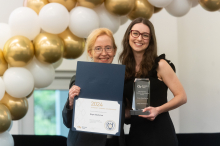
Their awards total more than $9.5 million in funding, the most Georgia Tech has ever had in the program.

We asked our postdocs whom they would like to extend their thanks. Their responses revealed the profound impact of collaboration, mentorship, and peer support.

Students from all six College of Sciences schools were recognized for excellence at this year's celebration.

Georgia Tech’s Climate Action Plan outlines mitigation and adaptation strategies for reaching net-zero emissions on campus by 2050 and contributing to global solutions through education and research.


